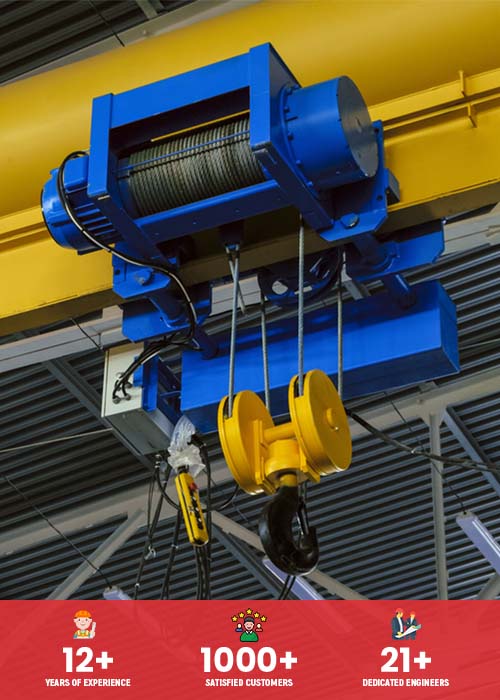Choosing the Right Hoist Crane: A Comprehensive Guide for Indian Manufacturers
Hoists are lifting apparatuses that use mechanical advantage to move items vertically and support hanging weights. They can be mechanical or electro-mechanical. Using pulleys or gears to convert small forces applied over long distances into larger forces applied over short distances, mechanical hoist equipment distributes weight. A barrel/drum, wheel, or other object has the chain or rope twisted around it. The chain or rope is then wound around pulleys or gears with various radii, some of which may be in the load block. Reeving is the arrangement that defines how a load’s force will be dispersed or transferred. Hoists can be used for common lifting tasks or for specialised ones, such removing an engine from a car. They can be employed in stationary or mobile applications. The hoist crane manufacturers in India takes care of certain traits that are needed for a quality hoist and crane. Let’s dig in further –
There are two major sub-divisions of hoists –
Manual and Powered hoists
Ratchet (lever-actuated) or hand chain operated lifting apparatuses, often known as manual hoists or chain falls, are also known as chain falls. The hand chain, which controls the rising and lowering motion, and the load chain, which supports the load, are the two chains that make up a manual lifting hoist.
One of the many forms of lifting equipment available are powered hoists, which come in three varieties: electric, air/pneumatic, and hydraulic.
The hoist crane manufacturers in India can help yu select the right one depending on the requirement.
What you need to look for in a hoist
Lift Capacity
The weight that the hoist can lift is referred to as its lift capability. This is based on the line material’s tolerance, usage patterns, power sources, and the structure the hoist is suspended from. Choose a hoist whose lifting capacity exceeds the weight of your biggest load.
Line Material
The medium through which a force will be applied to lift an object is the line material. Chain and wire rope or cable are the most often used line materials. Rope and straps or webbing can be utilised for smaller, lighter loads.
Power Source
The energy from the power source is what ultimately drives the gears that raise or lower the line material. Hand chains or levers are used to operate the most basic chain hoists. The majority of large weight hoists are electrically operated. The combustion of fuel, such as petrol and diesel, can power portable hoists. Hoists with air or hydraulic power are frequently employed in settings where electrical unit sparking is a concern.
Suspension Type
Simple hoist types can be hooked or bolted onto stationary fixtures or moveable supports to be suspended or put in fixed places. Other variants include hardware that enables them to be connected to overhead trolleys; these hoists can move along a rail by being pulled or pushed, or they can use independent motors.
Lift Height
The lift measures the distance between the load hook’s highest and lowest positions. The term “reach” refers to the result of adding headroom and lift.
Lift Speed
The rate at which a weight can be lifted is known as lift speed. Various or variable speeds are available in some models. The weight and height of the load may have an impact on lift speed. Hoists with a higher capacity typically have slower lifting rates. Some models offer flexibility when working with a variety of loads thanks to their multiple speeds.
Headroom
The distance between the rail or tread that the hoist is mounted on and the hook that is fastened to the load is known as the headroom of a hoist. Similar to mobile models, this can be calculated as the separation between the mounting point for the hoist and the lifting hook.
Applications and Industries
Hoists are utilised whenever a load has to be lifted and moved; they are not only used in industrial settings. Hoists are used for a variety of tasks, such as lifting goods, building supplies, machinery and stock in warehouses.
Hoists are employed in, but are not limited to, the following sectors:
- Automotive,
- Logging,
- Marine Manufacturing,
- Aerospace
- Mining



